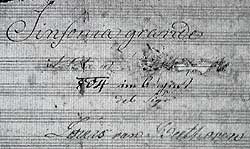
free from foible, is expressed in classical music better through Beethoven's compositions than in any other.
The culmination of this singularity, the exact pinpoint in time which marks the one composition that shines the brightest - that in my opinion is Beethoven's third symphony - called Sinfonia eroica [Heroic Symphony] (from Italian).
This link contains the Classical Notes description of the Eroica, a wealth of information, containing even a list of the best performances.

What about this evening's performance with Manfred Honeck and the Pittsburgh Symphony Orchestra? Well let's just reiterate the slogan they've adopted - Hear why the world cheers - it is because they continually produce the best performances of the greatest compositions. Tonight was a tour de force, one exceptional achievement by the orchestra and conductor Manfred Honeck, seemingly unequaled by any before or unlikely to be equaled again - a singularity of brilliance.
Before the Eroica we were treated to two other composition by Beethoven before intermission. First was the Consecration of the House overture. Interestingly, in the lobby was a TV monitor playing a film from 1971 of William Steinberg rehearsing with the PSO for the opening of Heinz Hall, and they were playing the same overture. So I had an opportunity to listen to that version, then minutes later to the 2011 PSO play it again. My thoughts were that they had similarities and differences. The Steinberg version seemed more striking on each note, as if to accentuate more heavily. the Honeck version seemed to flow more naturally without the accentuation. Now which is better, well that's hard to say, but this simple comparison was a great exercise, but not exactly scientific.
Next we were treated to the Beethoven Triple Concerto, performed by the PSO and the "Eroica Trio" with Erika Nickrenz - piano, Susie Park - violin and Sara Sant'Ambrogio - Cello. Having heard this fantastic composition for the first time tonight, I have to say I've been missing a gem that I'd really like to hear again. The balance between the trio and the orchestra was just right and the exquisite sounds by these three soloists was a unique experience. Each player had such a delicate touch, with pleasing sounds that interplay with excellent combination

After intermission came the Eroica. The Human Spirit was smiling - first 3 then 5 notes and I had goosebumps that continued throughout the first movement. The Kettledrum brought 4 beats that continued to reverberate through my soul. Pounding then flowing, soft then loud, fast then slow, alternating then simultaneous, surreal then palpable, building then descending, accenting then natural, and often coming to an eventual crescendo without actually ending, the first movement was presented as an inconceivable exercise in classical development with jaw dropping effect.
The second movement starts in the depths of melancholy, accented by an oboe, and carries forward with full strings. The drum beats a soft foreboding metronome, as cellos segway to the strings. Then a shuffle of the rhythm - a new aspect soon appears, as if an apparition sent to dispel the trance of the sad tenor. With the woodwinds comes a masterful mix-up, eventually sidling into another countenance by the bass. The drums beat more loudly - suddenly the melody becomes supplanted by a surprisingly optimistic demeanor flexing its new found vigor, with bold brass and drums. But are we done with the ancient lament - not yet - its back and soft - holding then transitioning into a march. But the tempo is uplifting and with feld drum beats the optimism is back. The whole world of concentration is focused on a distant light coming nearer, and at the same time melancholy returns, but it is broken. Bass and Brass sustain the new temperament. Now co-joined, the old and new tones mix to maximize the joyous developing flavor - human spirit cannot be defeated when we've got the proper outlook. The music pauses, takes a breath, regroups, plans, makes ready and ambles into the next movement with a charge.
The third movement seems like a musical joke, but after a bit it becomes more triumphant than anything else. It marches right along until we get the the 4th movement. Four notes and we finally see that point of creation. God created the universe out of the 6 subatomic types of quark, and yet Beethoven created the 4th movement of his 3rd symphony out of 4 notes. Those 4 notes are the elementary constituents out of which he combined variations and themes to develop the whole movement.


2 comments:
We are very lucky to have Maestro Honeck here in Pittsburgh. He is truly a giant among giants. I was unable to attend do to the Jewish new year "Rosh Hashana" so I greatly appreciate your play by play.
Thank you.
Thanks - I'm glad you liked the post.
Post a Comment